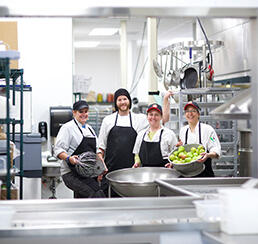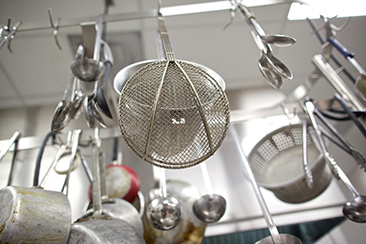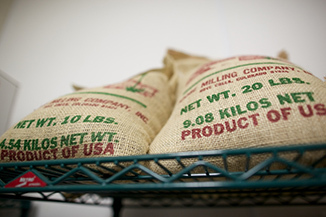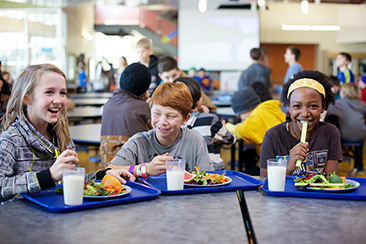
One of my favorite farmers, Joel Salatin often says if we want to save agriculture and the health of our country then we need to “find our kitchens” again. I’d like to take that thought one step further and say that if we want to save our children’s health, then we need to find school kitchens again. I believe that the way toward healthier school food is cooking, and to do that, we must find, build or rebuild school food infrastructure – the kitchens.
During the past 17 years of working in schools, I have accomplished this goal in different ways. I’ve managed schools cooking on their own, districts that have regional kitchens that cook for many schools, and now I’m in the process of designing and building one Central Kitchen (CK) for Boulder Valley School District (BVSD), which will serve over 13,000 meals per day for 52 locations. In my mind, cooking in a centralized environment will be the most efficient and cost effective model yet.
I’m often told that it’s counter-intuitive to think that better food can be had in a centralized production model. Many people have this idyllic vision of lunch ladies in their child’s school that cook just for their child. As bucolic and appealing as that vision might be, the reality of hundreds, if not thousands, if not tens of thousands of meals served every day, follows a much different paradigm. There is no “one-way” to feed students in schools, but I believe that there are realistic steps that school districts can take to make the best possible food in the most cost effective and efficient manner.
Why Move to a Central Kitchen?
Central Kitchens help support better tasting and higher quality food, a better bottom-line, and regional agriculture. To break that down, when we look at the consolidation of production, there are a number of factors to consider that can prove beneficial to school food operations:
- Equipment: using large-scale equipment and technology enhances efficiency.
- Storage: effectively using storage areas, including refrigeration (both coolers and freezers) allows for more regional sourcing of fresh produce.
- Staffing: minimizing staffing while integrating higher skill levels reduces overall staffing cost.
- Waste Reduction: transitioning to a central facility reduces waste and utilities use.
- Cost: using funds outside the typical operations budget (like bond or capital dollars) is essentially “free” money to build the facility and can reduce ongoing operational and food costs for years to come.
That being said, building a Central Kitchen is no easy task and takes a considerable amount of planning, time and expertise. BVSD first decided it would need a Central Kitchen after an assessment of food services was completed and presented to the school board in 2008. The District passed a bond measure in 2014 that included $10M for the kitchen. Since then we have been planning: running financial scenarios, visiting existing centralized facilities, creating future menus and recipes, working through future staffing budgets, thinking through equipment needs, building square footage and mapping out what we can do to start adjusting and enhancing the current system so that we will be ready when the Central Kitchen comes online.


That being said, building a Central Kitchen is no easy task and takes a considerable amount of planning, time and expertise. BVSD first decided it would need a Central Kitchen after an assessment of food services was completed and presented to the school board in 2008. The District passed a bond measure in 2014 that included $10M for the kitchen. Since then we have been planning: running financial scenarios, visiting existing centralized facilities, creating future menus and recipes, working through future staffing budgets, thinking through equipment needs, building square footage and mapping out what we can do to start adjusting and enhancing the current system so that we will be ready when the Central Kitchen comes online.
Start with the Vision
If you’ve decided to move towards a Central Kitchen, before any of the detailed planning takes place, the very first thing to do is to write and refine a vision statement that will serve as your roadmap for the entire project. When you begin the process of writing your vision statement, you pick a time in the future and express in as much detail as possible exactly what you’ll see, hear and feel when you walk into your Central Kitchen. Once you’ve done this, the rest will follow. Below are excerpts of the vision statement I wrote for the BVSD Central Kitchen. If you’d like to read the full statement, you can do so here. I hope it inspires you to consider this option and gives you a taste of why Central Kitchens are so important for school food change.
Vision Statement
On August 1st 2017 we had a ribbon cutting and local food celebration to commemorate the opening of the Boulder Valley School District’s (BVSD) new culinary facility. The Leed Certified Culinary and Nutrition Center (CNC) is a showcase for healthy, delicious scratch cooked school meals with a priority on buying and cooking with local food. The CNC will support 20,000 freshly prepared meals per day that are made from the highest quality ingredients possible given financial constraints assuming a yearly positive financial position. These meals include breakfast, lunch, snacks, catering, vending, Food Trucks as well as a Café. Total combined revenues top $20M annually with a 3% bottom line surplus.
Why go to all of this expense and use of scarce resources some might ask… the answer of course is the students. Our primary responsibility is to feed our students the healthiest possible food. In fact I often go so far as to say that it should be a birthright in our country that every child – every day has healthy delicious food in school and that no child is ever hungry. That is exactly what we’re doing in our CNC – assuring that all of our children are well nourished; body, mind and spirit and that they are knowledgeable in food literacy. Our passion for healthy food shines through in all we do; from the juiciest roast chicken, to the sumptuous ripe peaches to the rainbow colors of the fruits and vegetables prepped for the District salad bars – flavors overwhelmingly abound.

From a purchasing standpoint, the CNC will support local farmers and producers and place a high priority on local ingredients and products. We will cook with the least possible processed ingredients; 50% of our ingredients will be organic, natural, ABF and GMO free – 100% will be HFCS, added transfat, chemical and dye free. All of our food will be made with these high quality ingredients, with the exception of specific items such as tortillas, bagels and tamales, which will be made to our specifications and which will follow our vision.

From a purchasing standpoint, the CNC will support local farmers and producers and place a high priority on local ingredients and products. We will cook with the least possible processed ingredients; 50% of our ingredients will be organic, natural, ABF and GMO free – 100% will be HFCS, added transfat, chemical and dye free. All of our food will be made with these high quality ingredients, with the exception of specific items such as tortillas, bagels and tamales, which will be made to our specifications and which will follow our vision.
The Center, considered a Food Hub, will partner with local farmers and producers to assist in value added production and will service BVSD students as well as other schools, school districts and community organizations such as Meals on Wheels and Community Food Share. In this vein the CNC will host a weekly farmer’s market as well as serve as the meeting and training facility for the Food Service Team and an educational, marketing and outreach facility for the BVSD community as well as the larger National School Food and Farm to School communities.
The legacy of the CNC will be what we see on our student’s plates both at home and in school. Changing their palettes and eating habits will be the result of their hands-on experiential food experiences that the CNC will both guide and provide. These experiences will include every Elementary School (ES) student visiting a farm, the CNC, attend a cooking class, participate in a Salad Bar Rainbow Day, participate in numerous tastings and have the ability to participate in an Iron Chef competition. Every ES school will have a garden and the garden fruits and veggies will be served on the salad bars. Further, every ES student will know farm fresh flavors, taste dozens of new foods and will have a basic understanding of the relationship between healthy food, healthy kids and healthy earth.
As students matriculate into Middle School (MS) their experiences with food will become more sophisticated. At least two Iron Chef winning recipes will appear on the menu each year, which will be the culmination of their cooking classes. At least one of these competitions will include cooking from their school gardens and during BVSD’s Day at the Farmer’s Market, these students will do cooking demonstrations for the market’s customers. When the MS students participate in their yearly farm visit, they will focus on animal husbandry including animal welfare, animals as food and the relationship between CNC’s composting program and the animal’s feed. Finally these MS students will become the “Green Food Team,” which will mentor the ES students on their food choices and our food system.


As students matriculate into Middle School (MS) their experiences with food will become more sophisticated. At least two Iron Chef winning recipes will appear on the menu each year, which will be the culmination of their cooking classes. At least one of these competitions will include cooking from their school gardens and during BVSD’s Day at the Farmer’s Market, these students will do cooking demonstrations for the market’s customers. When the MS students participate in their yearly farm visit, they will focus on animal husbandry including animal welfare, animals as food and the relationship between CNC’s composting program and the animal’s feed. Finally these MS students will become the “Green Food Team,” which will mentor the ES students on their food choices and our food system.
Finally as our students are seeing graduation on the horizon, they will take with them from the BVSD experience a true sense of real food, a sense of seasons, of flavors, of the deliciousness of what’s on their plates, the balance between what they eat, how its grown and the sustainability of life itself. As our students begin their lives be it college or work or travel, our food and Food Literacy education will have positively impacted them for their lifetimes and with that we will have succeeded in changing the health of our nation’s children and perhaps saved the planet as well. Lofty goals from a kitchen – but real food can and will save the generations to come and the CNC will play a part in that!
Interested in reading more helpful articles from us?





